The Best of the Tenth Doctor
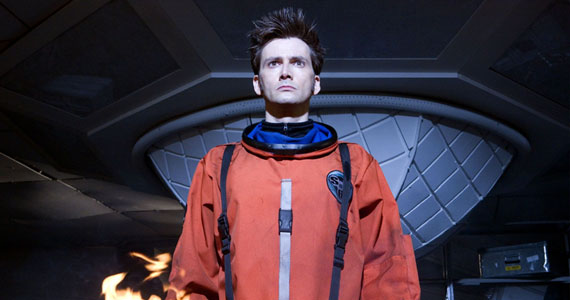
Patrick Kavanagh-Sproull looks at the best of David Tennant’s era.
“[David was] like all your birthdays and Christmas’ every day. He never complains about anything. Ever. Which was a bit weird at first, but that’s just him!” – Camille Coduri in February 2013.
Introduction
David Tennant is the most favourable modern Doctor. That is something that can’t be contested in any form. The charisma he injected into the role has made him immensely popular with fans of all ages and Tennant became one of the twenty-first century’s most in-demand actors. He successfully escaped the curse of typecasting; his performances in the critically applauded Hamlet and the more recent, highly commendable crime drama Broadchurch proved his wide range of acting abilities. I hold a high approbation for the man and I find each of his performances beguiling. Today marks David Tennant’s birthday and I thought it would be only respectful to count down some of the best hallmarks of his time on Doctor Who.
Top 3 Stories
3. Planet of the Ood.
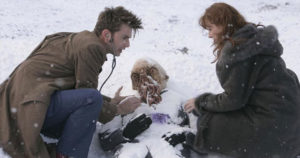 Planet of the Ood is, respectively, an allegory for humanity’s past ties with the now outlawed bondage system. It put the traditionally old-fashioned arrangement against a futuristic backdrop; an interesting contrast. It seems clear that scriptwriter Keith Temple was touched by creator Matt Jones’ portrayal of how the Ood were an enslaved race and elaborated on this conceit. The Doctor’s intervention into the inhuman company, Ood Operations succeeded in its intent and freed millions of the creatures across the galaxy. Donna was also given a valuable insight into just how brutal her own race could be, albeit future ones. This was also another step forward towards “The DoctorDonna”, an alias for her full maturation in the latter half of Series Four. David Tennant and Catherine Tate bounced incredibly well off each other’s dialogue and viewers started to see how their relationship could work. Tennant provided a consummate rendition of the Doctor, utilizing the soft voice he puts on when he explains something to an assistant. Undoubtedly Planet of the Ood is one of the strong highlights of Series Four, an often-overlooked jewel in the crown.
Planet of the Ood is, respectively, an allegory for humanity’s past ties with the now outlawed bondage system. It put the traditionally old-fashioned arrangement against a futuristic backdrop; an interesting contrast. It seems clear that scriptwriter Keith Temple was touched by creator Matt Jones’ portrayal of how the Ood were an enslaved race and elaborated on this conceit. The Doctor’s intervention into the inhuman company, Ood Operations succeeded in its intent and freed millions of the creatures across the galaxy. Donna was also given a valuable insight into just how brutal her own race could be, albeit future ones. This was also another step forward towards “The DoctorDonna”, an alias for her full maturation in the latter half of Series Four. David Tennant and Catherine Tate bounced incredibly well off each other’s dialogue and viewers started to see how their relationship could work. Tennant provided a consummate rendition of the Doctor, utilizing the soft voice he puts on when he explains something to an assistant. Undoubtedly Planet of the Ood is one of the strong highlights of Series Four, an often-overlooked jewel in the crown.
2. The Waters of Mars.
 The Waters of Mars was a story that took Doctor Who completely off the family-oriented path. It placed the hero, a normally devil-may-care, happy-go-lucky figure in a situation where he had no control over his surroundings, as was the norm really – the Doctor was rarely put in a scenario where he couldn’t change anything as it was “in flux”, a term used often in the Matt Smith years. The Tenth Doctor was paired with a new, completely different companion; Adelaide Brooke and his TARDIS (a deus ex machina) subtracted from the story. The Waters of Mars is probably most remembered for being unusually dark and that is why fans like it. It dared to strike off nearly everyone on its guest star list, and have multiple, gruesome demises. I like this element, it most definitely spooked me when I was a child but I find that it isn’t entirely where the charm lies. What I like about The Waters of Mars is that it furthered the sinful side of the Tenth Doctor that hadn’t been touched on fully. He spent most of the episode seeking an honest and viable escape route for him and the other characters but then “the Time Lord Victorious” struck him. He received a newfound arrogance and set himself up as a godlike alien, the last of his race, and now the only one holding the reins. He had limitless ideas as to how he could change the cosmos. It would have been wonderful for the series to have explored this further but sadly David Tennant left in the following story, The End of Time. Tennant gives his all in The Waters of Mars, and puts a great amount of effort into his performance, showing a dark side to a character we have loved for so long for his upright ethics and deep-seated enthusiasm.
The Waters of Mars was a story that took Doctor Who completely off the family-oriented path. It placed the hero, a normally devil-may-care, happy-go-lucky figure in a situation where he had no control over his surroundings, as was the norm really – the Doctor was rarely put in a scenario where he couldn’t change anything as it was “in flux”, a term used often in the Matt Smith years. The Tenth Doctor was paired with a new, completely different companion; Adelaide Brooke and his TARDIS (a deus ex machina) subtracted from the story. The Waters of Mars is probably most remembered for being unusually dark and that is why fans like it. It dared to strike off nearly everyone on its guest star list, and have multiple, gruesome demises. I like this element, it most definitely spooked me when I was a child but I find that it isn’t entirely where the charm lies. What I like about The Waters of Mars is that it furthered the sinful side of the Tenth Doctor that hadn’t been touched on fully. He spent most of the episode seeking an honest and viable escape route for him and the other characters but then “the Time Lord Victorious” struck him. He received a newfound arrogance and set himself up as a godlike alien, the last of his race, and now the only one holding the reins. He had limitless ideas as to how he could change the cosmos. It would have been wonderful for the series to have explored this further but sadly David Tennant left in the following story, The End of Time. Tennant gives his all in The Waters of Mars, and puts a great amount of effort into his performance, showing a dark side to a character we have loved for so long for his upright ethics and deep-seated enthusiasm.
1. Tooth and Claw.
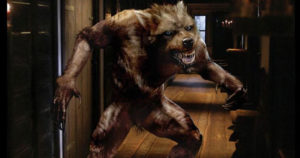 Tooth and Claw may not have an entirely impeccable plot nor too wondrous supporting characters but it’s my favourite episode of the Tenth Doctor era for certain reasons. David Tennant had just stepped into the blue box, following Christopher Eccleston’s immensely powerful and insurmountable interpretation, and was now in his third episode. He had fit in perfectly and fans were not at all hesitant at the new incarnation – I draw parallels to new companion [modern day] Clara, who by Cold War, her third episode has been warmly accepted into the fan community. Tooth and Claw was not just significant, in my eyes, for the character of the Doctor but also his and Rose’s relationship. In this episode she finally accepts the new version of the Doctor and starts to really ‘go’ with him as shown in the opening scene in the TARDIS. David Tennant’s acting is truly sublime and I wish he would return but… oh wait…
Tooth and Claw may not have an entirely impeccable plot nor too wondrous supporting characters but it’s my favourite episode of the Tenth Doctor era for certain reasons. David Tennant had just stepped into the blue box, following Christopher Eccleston’s immensely powerful and insurmountable interpretation, and was now in his third episode. He had fit in perfectly and fans were not at all hesitant at the new incarnation – I draw parallels to new companion [modern day] Clara, who by Cold War, her third episode has been warmly accepted into the fan community. Tooth and Claw was not just significant, in my eyes, for the character of the Doctor but also his and Rose’s relationship. In this episode she finally accepts the new version of the Doctor and starts to really ‘go’ with him as shown in the opening scene in the TARDIS. David Tennant’s acting is truly sublime and I wish he would return but… oh wait…
Top 4 Original Companions
Note: ‘original’ is defined as a character who was created and introduced into the period in which David Tennant portrayed the Doctor.
4. Wilfred Mott (The End of Time)
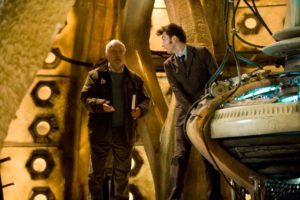 Russell T Davies fulfilled the character of Donna Noble’s kindly grandfather’s wish to travel alongside the Doctor. Wilfred Mott appeared in eight stories, usually watching the TARDIS leave and/or encouraging Donna to go with the Time Lord. It felt only right for him to become the official companion for at least one story; David Tennant’s swansong, The End of Time. Although he didn’t serve the ‘assistant’ role too well, it was still nice for Wilf to be there, making hilarious and jocular comments:
Russell T Davies fulfilled the character of Donna Noble’s kindly grandfather’s wish to travel alongside the Doctor. Wilfred Mott appeared in eight stories, usually watching the TARDIS leave and/or encouraging Donna to go with the Time Lord. It felt only right for him to become the official companion for at least one story; David Tennant’s swansong, The End of Time. Although he didn’t serve the ‘assistant’ role too well, it was still nice for Wilf to be there, making hilarious and jocular comments:
“I know you though. I bet you’ve got a plan, haven’t you? Eh? Come on. You’ve always got a trick up your sleeve. Nice little bit o’ the Doctor flim-flam, sorta thing, eh?”
His cheerfulness and optimism was uplifting in an otherwise dark episode and Bernard Cribbins is superlative throughout. It would be nice to see him return, although I’m not quite sure how the relationship would work between Wilfred and the Eleventh Doctor.
3. Martha Jones (full majority of Series Three followed by sporadic appearances in Series Four, a cameo in The End of Time)
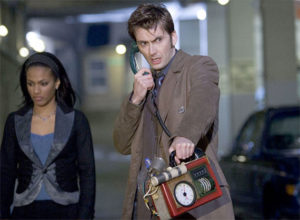 Before I launch into a spiel on why I adore the character of Martha Jones so much, I divert you to Mark Spurdle’s in-depth analysis here. He conveys all my feelings about the criminally underrated assistant, and more. The Doctor is on the rebound when he meets Martha; he attempts to distract himself by investigating around the Royal Hope Hospital and when the infirmary is transported to the moon, he meets her. She had the kind-hearted and warm nature that every companion held except she possessed it more; she was a medical student and thus her job was to tend to others. Martha was sharp, and she knew what do in sudden dangerous scenarios (when the Macra attacks the cab in Gridlock, Martha is quick to find a solution). She and the Doctor’s relationship was by far the more interesting than Rose and his. It was only once Martha had departed life in the TARDIS, did the Doctor realize just how much of a valuable friend and assistant she was.
Before I launch into a spiel on why I adore the character of Martha Jones so much, I divert you to Mark Spurdle’s in-depth analysis here. He conveys all my feelings about the criminally underrated assistant, and more. The Doctor is on the rebound when he meets Martha; he attempts to distract himself by investigating around the Royal Hope Hospital and when the infirmary is transported to the moon, he meets her. She had the kind-hearted and warm nature that every companion held except she possessed it more; she was a medical student and thus her job was to tend to others. Martha was sharp, and she knew what do in sudden dangerous scenarios (when the Macra attacks the cab in Gridlock, Martha is quick to find a solution). She and the Doctor’s relationship was by far the more interesting than Rose and his. It was only once Martha had departed life in the TARDIS, did the Doctor realize just how much of a valuable friend and assistant she was.
2. Adelaide Brooke (The Waters of Mars)
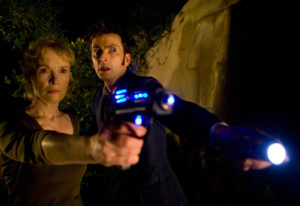 Adelaide Brooke, companion to the Tenth Doctor in the 2009 special The Waters of Mars was utterly distinct. Lindsay Duncan was one of the Doctor’s oldest companions (only to be superseded by Bernard Cribbins one episode later) and also one of the most distant. She didn’t take to the Doctor instantly as the best part of companions do, and remained hostile throughout the entire story, she even threatened to kill him. Her astuteness and quick-witted thinking meant she was a valuable assistant but not a friend to the Doctor. I chose Adelaide as number two because she was nothing like we had seen. Dissimilar to previous travellers, Adelaide did not want to be a part of the Doctor’s life. She might have thought differently had the character appeared in another story, in an Earth-based, non-claustrophobic environment. But she met the Tenth Doctor when he (knew he) was reaching the end of his life and of course, “the Time Lord Victorious” realization hit him. Adelaide ultimately chose to end her life, as she knew the Doctor had acted unacceptably.
Adelaide Brooke, companion to the Tenth Doctor in the 2009 special The Waters of Mars was utterly distinct. Lindsay Duncan was one of the Doctor’s oldest companions (only to be superseded by Bernard Cribbins one episode later) and also one of the most distant. She didn’t take to the Doctor instantly as the best part of companions do, and remained hostile throughout the entire story, she even threatened to kill him. Her astuteness and quick-witted thinking meant she was a valuable assistant but not a friend to the Doctor. I chose Adelaide as number two because she was nothing like we had seen. Dissimilar to previous travellers, Adelaide did not want to be a part of the Doctor’s life. She might have thought differently had the character appeared in another story, in an Earth-based, non-claustrophobic environment. But she met the Tenth Doctor when he (knew he) was reaching the end of his life and of course, “the Time Lord Victorious” realization hit him. Adelaide ultimately chose to end her life, as she knew the Doctor had acted unacceptably.
1. Donna Noble (The Runaway Bride, the full majority of Series Four, a supporting role in The End of Time)
 Although Donna isn’t as disliked as Martha, she still seems to receive a lot of criticism, and this largely boils down to her attitude. Those who don’t take any liking to her have this opinion because of her first appearance. Russell T Davies wrote the character of Donna Noble into The Runaway Bride because he needed the traditional companion and a celebrity for the festive special. Catherine Tate doesn’t stand out in the list of personalities Davies could have chosen but in retrospect, it was one of biggest and best casting choices of the revived series.
Although Donna isn’t as disliked as Martha, she still seems to receive a lot of criticism, and this largely boils down to her attitude. Those who don’t take any liking to her have this opinion because of her first appearance. Russell T Davies wrote the character of Donna Noble into The Runaway Bride because he needed the traditional companion and a celebrity for the festive special. Catherine Tate doesn’t stand out in the list of personalities Davies could have chosen but in retrospect, it was one of biggest and best casting choices of the revived series.
I didn’t like her in The Runaway Bride; I felt she was bawled at the Doctor continuously, she never had anything serious to say and she detracted my enjoyment of an otherwise lighthearted and fun story. When I heard Tate was returning I was incredibly hesitant and peeved. The idea of thirteen weeks of some annoying loud-mouthed Londoner screaming at the Doctor was not a pleasant one. Notwithstanding I found myself loving the Donna we see in Partners in Crime. She had spent the previous two years scouring the globe for signs of the Doctor, pursuing alleged UFO sightings and even crop circles. Within her first three episodes, I was hooked on her. Her humaneness and compassion towards the Pompeii townspeople [in The Fires of Pompeii] and her understanding and mercifulness [in Planet of the Ood] when she met the enslaved Ood was exactly what I wanted in a character. As episodes progressed, I found myself growing more and more attached to Donna, and that is why her departure really hit home to me.
I haven’t been able to watch Journey’s End for a very long time. The way in which Donna leaves is so tragic that I find myself incapable of viewing the episode entirely. When I finally looked back at it recently, I was overwhelmed with a familiar sadness. You’d have to have a stone-cold heart to not find it heart-wrenching.
Top 4 Original Monsters/Villains
Note: ‘original’ is defined as a monster/villain who was created and introduced into the period in which David Tennant portrayed the Doctor.
4. The Beast from The Impossible Planet/The Satan Pit.
 The idea of Satan embodied is an extremely dark and discomforting one for a family oriented show such as Doctor Who. The Beast was one of the most frightening of all of the revived series’ monsters. His terrifying appearance and the chilling voice he has when speaking through computer outlets really added up to a memorable and spin-tingling monster.
The idea of Satan embodied is an extremely dark and discomforting one for a family oriented show such as Doctor Who. The Beast was one of the most frightening of all of the revived series’ monsters. His terrifying appearance and the chilling voice he has when speaking through computer outlets really added up to a memorable and spin-tingling monster.
3. The Vashta Nerada from Silence in the Library/Forest of the Dead.

2. The Ood from The Impossible Planet/The Satan Pit.

1. The Weeping Angels from Blink.

The 50th Anniversary Special

This news couldn’t have come at a better time and I’m so excited for November to see Tennant back in the brown suit and Converses. Billie is a fantastic actress and I’m sure many of you will be missing her too. So roll on, November!








